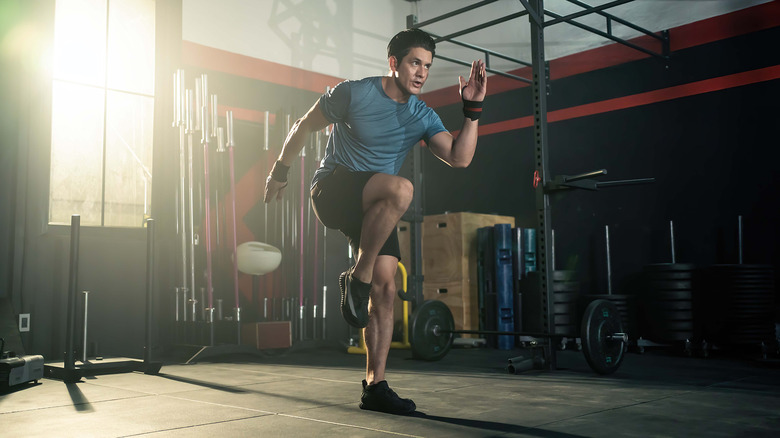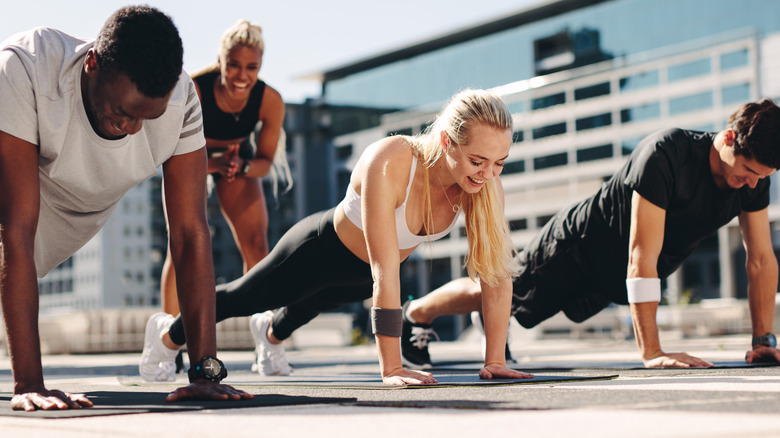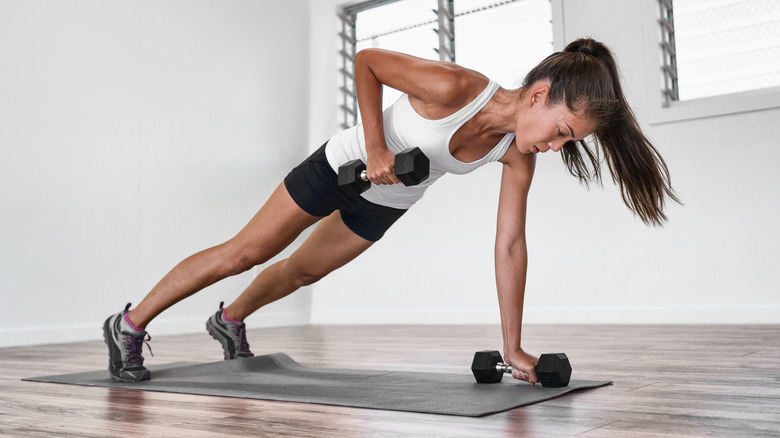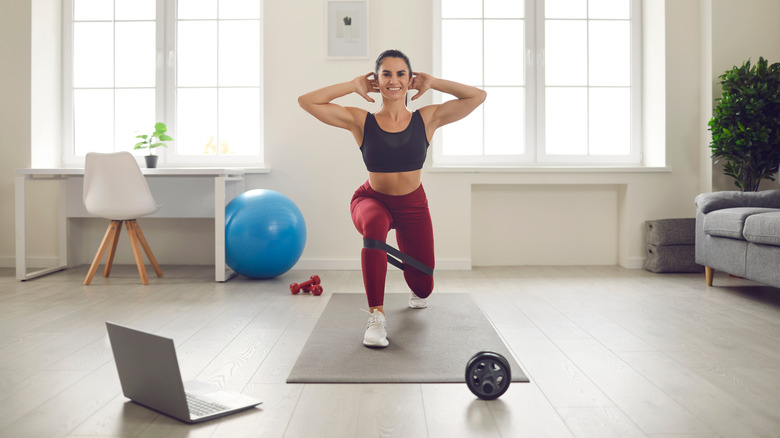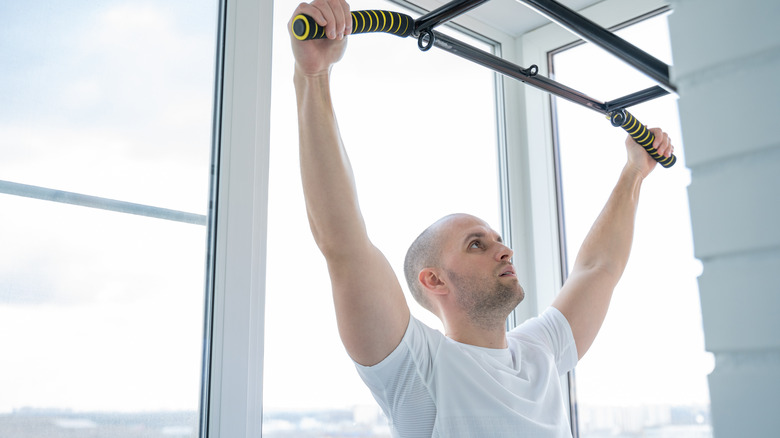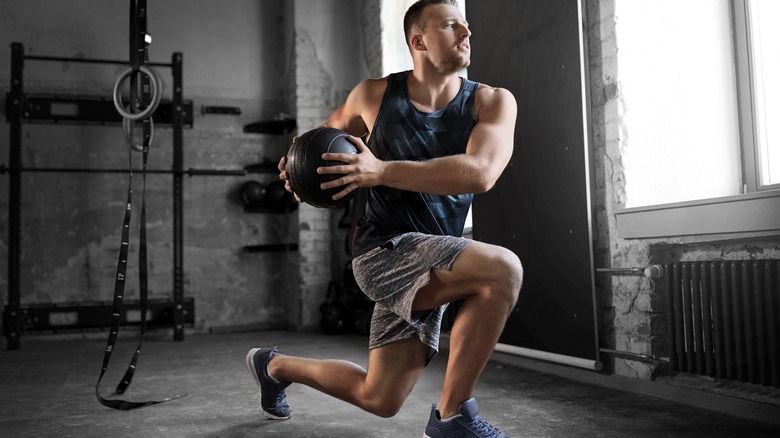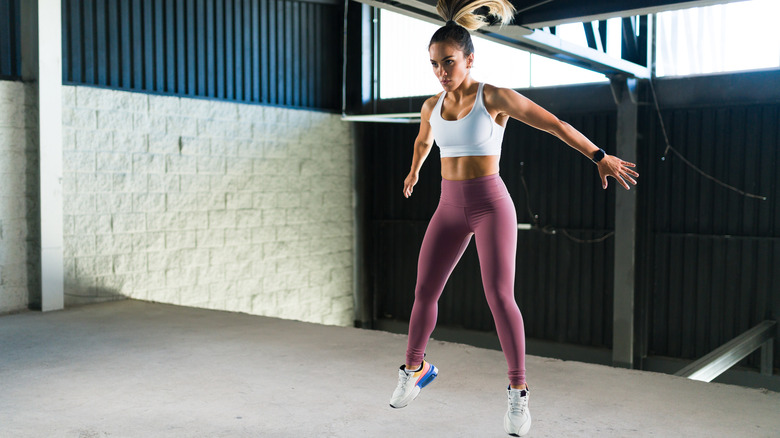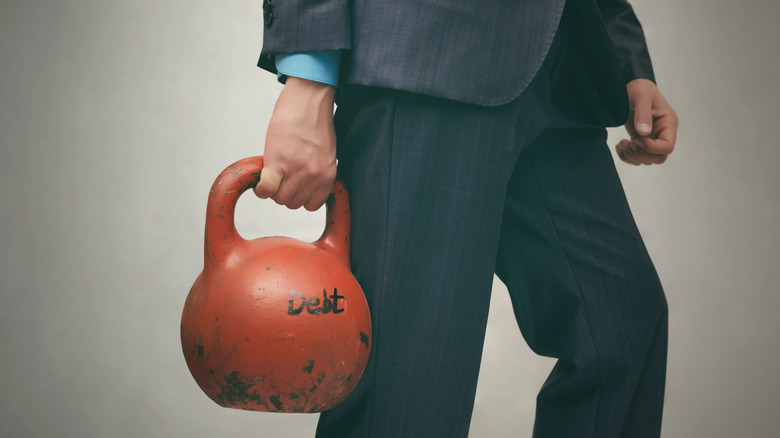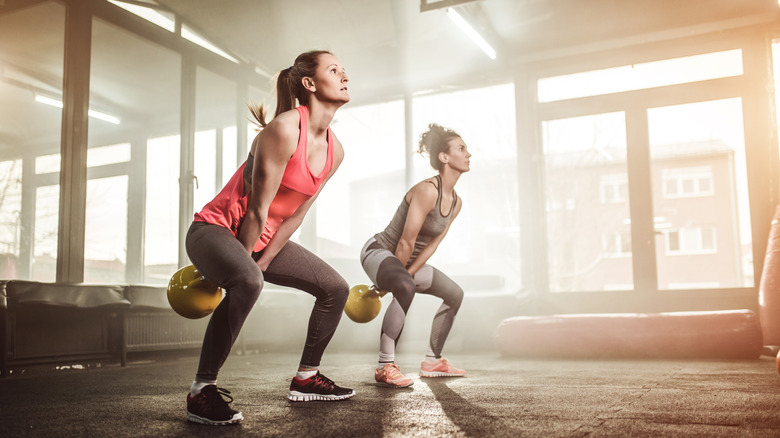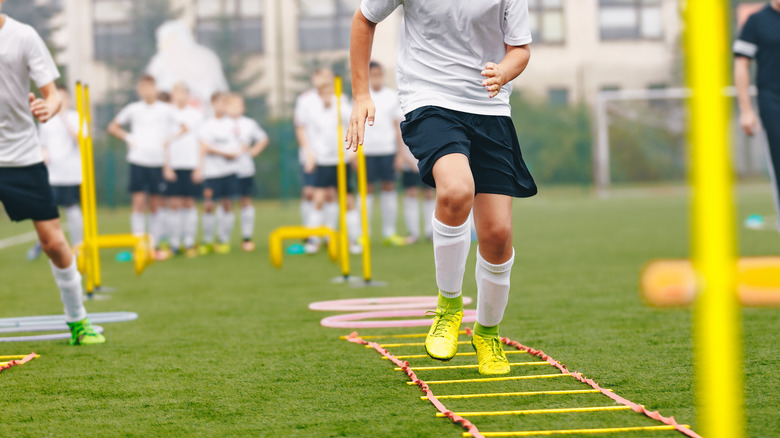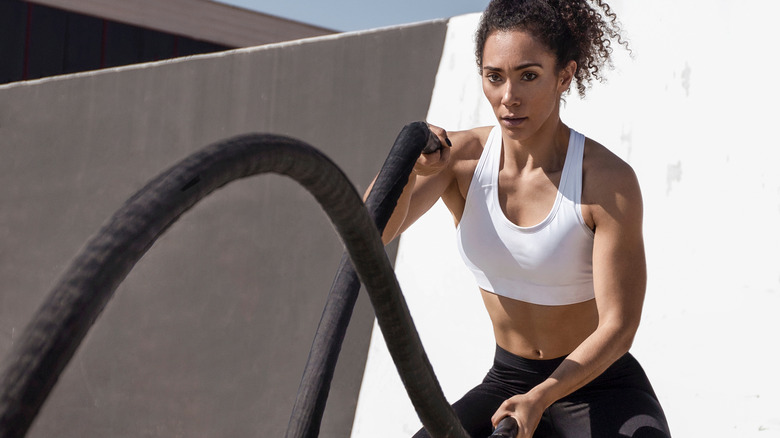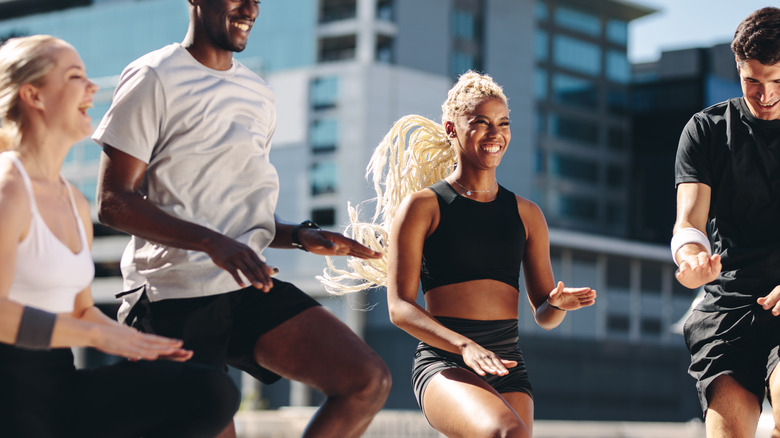14 Functional Training Exercises You Should Be Doing
Functional fitness is a term that describes exercise movements that mirror activities or motions that you may often make every day (via Self). For instance, you probably frequently sit down and stand up, actions that a squat also utilizes. And functional training is so important precisely because it helps prepare your body for these everyday movements, building the strength, balance, and coordination you need to perform daily tasks safely and efficiently, and to avoid injury.
Functional training movements are "compound exercises," meaning they activate more than one muscle group at a time, rather than working a single muscle group in isolation (as you would with a bicep curl, for instance). To perform functional exercises, your body will also require space to move in all directions — this is in contrast to, say, weight machine exercises, which are generally non-functional as they force you to move in a limited and very specific way. That's not to say you can't upgrade your functional movements with accessories — indeed, as we'll discuss, you can utilize items such as free weights, battle ropes, and resistance bands to make the most of your functional exercises (via Men's Health)
Let's dig into some of the functional exercises you should be adding to your routine to help keep your body strong, capable, and healthy.
Pushups
Given the number of things we push in real life — grocery carts, doors, kids on a swing — pushups are a vital exercise to help build the strength we need to perform these tasks easily and keep muscles like our rotator cuffs from injury (Verywell Fit). The National Academy of Sports Medicine (NASM) suggests starting with incline pushups to get your muscles used to the movement before going on to more advanced versions.
Use a bench, box, or other stable surface around hip height to start. Put your hands on the surface and walk your feet back until you're in a pushup position. Using your arm muscles, lower yourself down, getting your chest as close as possible to the surface. Then press yourself back up until your elbows are straight. If this is too easy, find a lower surface. You can also start by doing pushups with your hands and knees on the ground. Once you feel more comfortable, you can progress to regular pushups on your hands and feet.
For a more advanced version of pushups, NASM recommends adding a rotation at the top of your regular pushup. After you descend and push yourself back up to the starting position, rotate to the right with your shoulders and reach your right arm up to the ceiling. Reset, descend, and repeat on the left side.
Bent over row
Rows are a useful functional exercise because they work your back muscles and help you pull objects in toward yourself (via Healthline). You can do bent over rows, a functional exercise recommended by NASM, with a barbell, dumbbells, or a weight plate.
Start standing with the weight in your hands. Push your butt back, keeping your back flat and your knees over the middle of your feet. Once you're bent over, you can row by pulling the weight up and back toward your stomach. As you get to the top of the row, begin to squeeze your shoulder blades together to activate more of your back muscles. Pause at the top of the movement, then lower the weight back down.
There are other variations recommended by the NASM if this version of the row is too easy. For example, you can do a renegade row. To do these, start with a weight that's lighter than what you'd use for a bent over row. Put two dumbbells on the ground and get into a pushup position with your hands on the grips. Pull one dumbbell off the ground, row it up to your body, then drop it down and switch.
Goblet squat
Squats help build your leg and core muscles, preparing them for everyday activities like sitting down in a chair or picking something up off the floor (via Healthline). However, you can make squats even more functional by holding a weight in front of your chest. The goblet squat is a functional exercise that's useful for beginners (via NASM). You can use a dumbbell, kettlebell, or even an everyday item like a can of soup to add resistance to this variation of the squat.
Hold the weight you selected in your hands, directly in front of your chest — try to push your back muscles in toward each other as you do this. Set your feet about shoulder-width apart. Squat down as low as you comfortably can, keeping your back flat, feet flat on the ground. Then stand back up to complete the rep. As you get used to the exercise, you can add a heavier weight to make it harder. NASM suggests doing a dumbbell squat if the goblet squat becomes too easy. To do so, hold a dumbbell in each hand by your sides and squat. This is similar to holding heavy grocery bags in each hand.
Step-ups
No matter how athletic you are, climbing stairs can be exhausting. But the good news is, with training, you can improve your climbing strength, balance, and stability (via MasterClass). And as an article published in the American College of Sports Medicine's Health and Fitness Journal points out, functional exercises like the step-up require minimal equipment to get started. The step-up mimics stair climbing, which can help build the muscles and stamina you use for that everyday activity. With the step-up exercise, all you need is a knee-high box, bench, or other sturdy object (via MasterClass).
To start, put one foot on the step and use that leg to raise your body up to a standing position. Then lower down and switch legs. Continue with that pattern for 6-10 repetitions per leg for 2-3 sets. To increase the difficulty or switch up the primary muscles activated, you can add weights, change the size of the step (lower to activate your quads more, higher to work your hamstrings and glutes), or perform the step-up in a sideways (lateral) position.
Multidirectional lunges
One of the benefits of functional exercise is the ability to move in multiple directions. According to an article in the American College of Sports Medicine's (ACSM) Health & Fitness Journal, athletes might not benefit as much from traditional exercises such as treadmill running because the movement only goes in one direction. In sports and in real life, though, you often need to move in different directions. For example, a soccer play might need to move left or right or diagonally to chase a ball. To train for those kinds of movements, the ACSM recommends multidirectional lunges.
Start in a standing position. Take a lunge step forward with your left foot and bend until your knee is at a 90-degree angle, then step back to the standing position (via Well Balanced). Next, step out straight to your left side and lean into the left leg, bending the knee. Step back to the center. Finally, step the left leg back into a reverse lunge, then step back to center. After this sequence, repeat the same thing with your right leg. Some variations of this sequence also include lunges at a 45-degree angle both forward and backward (via Protein Works).
Stair climbs
Although the step-up exercise is helpful for building up the strength to climb stairs, eventually you will also benefit from just doing the real thing. And not only will climbing stairs activate your leg muscles, it will also help increase your stamina and get your heart rate pumping (via Run Society). The American Council on Exercise (ACE) recommends finding a set of stairs to climb that gives you plenty of room. Stairs in your house could work, but you can also go to a sports arena or park for a flight of stairs.
Run Society notes that the benefits will vary based on your speed and intensity — running up the stairs is more intense than walking, obviously — but adds that you can increase your intensity over time. ACE also suggests climbing stairs in unique ways to work different muscle groups or make your workout harder. For example, you can face sideways and climb the stairs laterally, or try skipping every other step.
Isometric pull-up hang
For many people, pull-ups are intimidating, or they may just be out of reach. But even if you can't do a pull-up, you can still benefit from doing an isometric pull-up hang. All you need is a bar to hold onto that is high enough that you can hang in a pull-up position without your feet touching the ground (via ACE).
Start under the bar. Reach up and grab it, with your hands roughly shoulder-width apart, your palms facing away from you. From that position, pull yourself up — or jump up, if you cannot pull up with your arms — until your chin is over the bar, and you're hanging in pull-up position. ACE explains that you should hold this position until your form begins to deteriorate. Then you can let go, shake your arms out, then jump up and repeat. You should track the amount of time you are able to hang on the bar and try to increase it every workout.
Kneeling medicine ball throw
Using objects like a medicine ball can help enhance your training in a variety of ways. Medicine balls are weighted rubber balls that come in a variety of shapes and sizes (via Healthline). They can be used as a general weight to enhance activities like lunges or single-leg deadlifts, or they can challenge your balance in exercises like mountain climbers if your hand grip is on the ball rather than the floor. And medicine balls can also be thrown from a variety of different positions, to activate different muscles (via Fitpro).
For a kneeling overhead throw, grab a lighter medicine ball. From a kneeling position, use both arms to throw the ball, lifting it behind your head and then throwing it forward as hard as you can. You can either perform this in front of a wall so the ball bounces back to you, or perform with a partner who can return it. From a kneeling position you can also perform lateral, or sideways, throws.
Jump squat
Many athletes need to jump in their sport: Basketball players have to jump when they shoot the ball, volleyball players have to jump to spike the ball, and some track and field events are specifically about how high or far you can leap (via SportsRec). The jump squat is an exercise that mimics the type of jumping an athlete might do in sport, but it can be used by people who aren't athletes as well. If you've ever had to jump to reach an object in your closet or to avoid a puddle, you know that jumping is a useful life skill.
University Hospitals recommends the jump squat as a functional exercise because it works the leg muscles and teaches you how to balance. Start with your feet shoulder-width apart or slightly wider. Drop down into a squat position with your feet flat on the ground, butt back, and knees bent (via Men's Health). Then, using both your legs and arms to propel you upward, explode up into the air and jump. Land softly on your feet, bending your knees and hips slightly to absorb the impact.
Farmer's carry
Originally known as the Fergus walk, the farmer's carry originated as a strongman event (via World's Strongest Man), but nowadays it's known as a functional exercise that can benefit most anyone. After all, you've likely had to carrying heavy bag of groceries home from the store, or hold your suitcase as you run through the airport to catch a plane — these are prime examples of the need for functional carrying strength.
At its core, the farmer's carry simply involves walking while holding weights in each hand (via Healthline). Many people use kettlebells or dumbbells since these are easy to grip, but other weighted objects will work as long as they can be lifted and carried in one hand. To start, bend your hips and knees and pick up your objects, one in each hand, and then straighten to stand tall with proper posture. Slowly walk forward, maintaining a steady pace, until you reach the end of your walkway or feel the need to drop the weights. Put the weights down, take a rest, and then repeat. You can use heavier weights or walk for a longer distance to make the exercise harder.
Kettlebell swings
Athletes who are looking for a way to be more explosive on the field can benefit from the kettlebell swing. Indeed, a study published in the Journal of Strength and Conditioning Research found that subjects who did kettlebell swings twice per week had similar improvements to their explosive strength as athletes who did jump squats — which is significant because it means that people who want to avoid the impact on their joints from jumping can do kettlebell swings instead (via Healthline).
To do a swing, start with a kettlebell in front of your feet. Standing with your feet at shoulder-width, squat down and grab the bell with both hands. Swing the kettlebell back between your legs while maintaining a flat back. Then stand up as you swing the kettlebell upward until your arms are parallel to the ground, then bend and swing back down again. Keep your feet flat on the ground as you swing, and continue for 10-20 repetitions. And remember, this exercise should primarily be activating your legs and glutes — your arms shouldn't be doing most of the work.
Agility ladder
Footwork is an important part of many sports and activities of daily life. Boxers, soccer players, rugby players, and many other athletes need to have strong footwork to perform their moves swiftly and nimbly (via PreGame Fitness). Being light on your feet can boost your sports performance, but it also helps with things like dancing at a wedding, or avoiding a fall after you step on a stray LEGO.
An agility ladder is a plastic ladder that you lay flat on the ground, and with this equipment you can do a number of footwork drills (via Verywell Fit). For instance, you can run across, putting one foot in each opening, or to practice smaller running movements you can place both feet in each opening before moving to the next. You might also move down the ladder sideways, placing one foot in each opening in a lateral movement, or jump or hop down the ladder.
Battle ropes
Battle ropes provide a functional exercise that is good for improving grip strength and mobility, and challenging the balance of your entire body (via Evo Fitness). Shape recommends a circuit of eight different movements, but there are a couple basic ones to get you started.
To perform your battle ropes workout, grab the loose end of the ropes, holding one rope in each hand. Sit your butt back and lean forward slightly before you start. To begin, you can perform a single-arm wave, in which you move both arms up and down at the same time, as high up and low down as they can go, as quickly as you can — this will make "waves" in the rope, thus the name. In a double-arm wave you move your arms in opposite directions, one going up while the other goes down.
There are also variations you can incorporate into single- or double-arm waves to amp up the difficulty. In a single-arm wave, you can perform jump-squats while continuing to move your arms. To add an element to double-arm waves, stop and do a burpee after three waves.
High-intensity functional training
High-intensity functional training (HIFT) could be your next favorite workout. It's not an exercise, but rather a way to structure your workouts, combining elements of high-intensity interval training (HIIT) and functional training. Why is this important? As ACE explains, many strength-training exercises don't provide a sufficient cardiovascular workout. By taking traditional strength training exercises and putting them into a fast-paced circuit, you get a strength and cardio workout.
Doing your functional training exercises in a circuit allows you to save time but doesn't diminish your results — indeed, according to Healthline, circuits can boost your endurance, strength, and cardio health. To get started with HIFT, ACE suggests doing squats, kettlebell swings, and sprints in a circuit for 30 seconds per exercise. After completing all three exercises, take a 30-second rest before repeating the circuit. Repeat that for five rounds. You can swap out other exercises such as rope slams, medicine ball throws, or sled pushes for a fast-paced functional workout.

